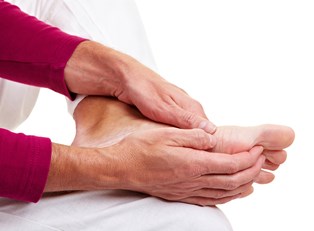Diabetes is a chronic disease that causes high levels of sugar in the blood because the body either does not produce enough insulin or utilize it properly. One of the common symptoms of diabetes is foot pain caused by reduced blood flow and peripheral neuropathy.
Peripheral neuropathy is nerve damage that can lead to numbness, extreme pain, or a combination of both. Sometimes the sharp pain can be so sensitive that even the softest touch, such as contact with the sheets on your bed, can be excruciating.
Diabetic foot pain is particularly problematic because the decreased circulation in your feet makes it more difficult for sores and blisters to heal, and the nerve damage can cause your feet to become numb, causing these ailments to go unnoticed. When you can’t feel these minor problems in your feet, then you can’t treat them, and they therefore have a greater chance for becoming infected. In extreme cases, deep infections can sometimes lead to amputation.
Treatment
If you are experiencing nerve pain caused by your diabetes or if your muscles have become weak from nerve damage, investing in custom shoe inserts called orthotics might be beneficial for you. Sometimes the pain and weakness is so severe that it makes it difficult to walk, so foot braces or special orthopedic shoes might be a good option as well. You will need to visit your podiatrist in order to find out if these items are right for you.
Non-impact exercise is another option for increasing your circulation in your feet. This type of exercise includes things such as swimming, cycling, yoga, and tai chi. These activities work by raising your blood flow while also having minimal impact on your feet. There is a variety of exercise programs geared towards diabetics with related foot pain that might be effective in treating your diabetic neuropathy.
Prevention
Taking care of your feet is a good way to ensure your diabetic neuropathy doesn’t cause sores or infections. Wash your feet daily in warm water, and inspect them for any cuts or scrapes that you might not be able to feel due to the numbness. Make sure that you choose shoes that fit correctly, as tight or uncomfortable shoes are very prone to leading to blisters, redness, and swelling.
Another factor that contributes to diabetic neuropathy is smoking. Because smoking is also hard on your circulatory system, abstaining from this habit will lower your risk of developing peripheral neuropathy.
Ultimately, the best way to avoid dealing with diabetes-related foot pain is to manage your diabetes well. The two most important factors that determine your risk of diabetic neuropathy are how many years you’ve had diabetes and how well you control your blood sugar. While one of these factors is out of your control, you do have the power to maintain a steady, healthy blood sugar level by sticking with a nutritious diet, exercising regularly, and taking any medications prescribed to you.



